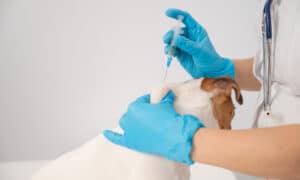“This post contains affiliate links, and I will be compensated if you make a purchase after clicking on my links.”
Recognizing and preventing your dog from contracting canine distemper must be one of the top health priorities of all dog owners. If left untreated this very infectious disease will be fatal to your dog, so read below how to be aware of the symptoms so you can get your dog to the vet for immediate treatment.
Canine distemper
First, it is important to keep in mind puppies and young dogs who have not received the proper vaccinations for this deadly disease are at most risk. Having said this, all dogs are susceptible if they have yet to be vaccinated. Fortunately, canine distemper has been relegated to isolated outbreaks as more dog owners have a better understanding of what to look for, and timely prevention shots as well as secondary treatment improvements.
Your dog can contract this disease several ways: contact with other infected dogs, foxes, ferrets, and several other wild animal species. The virus is transmitted by secretions from the infected animal but the most common method is airborne transmission. If you know of another dog that has been infected by canine distemper and successfully treated you must keep your dog from any contact with this animal as the virus is still present for several months and can still be spread. Quarantine is what this animal must be under to keep from infecting other animals.
It is believed that the disease originally developed in dogs in the late 1800’s to early 1900’s, source undetermined. They in turn have infected and possibly wiped out several wild animal populations, so the disease continues to spread in spite of inoculations. According to a Wikipedia article:
The domestic dog has largely been responsible for introducing canine distemper to previously unexposed wildlife, and now causes a serious conservation threat to many species of carnivores and some species of marsupials. The virus contributed to the near-extinction of the black-footed ferret. It also may have played a considerable role in the extinction of the thylacine (Tasmanian tiger) and recurrently causes mortality among African wild dogs. In 1991, the lion population in Serengeti, Tanzania, experienced a 20% decline as a result of the disease. The disease has also mutated to form phocid distemper virus, which affects seals.
Symptoms to watch for if you suspect your dog has been infected include an elevated temperature, sore throat, and runny nose, as seen in the accompanying photo. And the eyes will begin to water excessively. These initial symptoms normally take several days before becoming noticeable. The virus will move into the next stage in a few days with your dog developing diarrhea and the tonsils become enlarged. By one month into infection the dog will begin to twitch as the brain becomes affected. Convulsions are next and by this stage it is often too late to save the dog and euthanasia is recommended. There is very little you can do for your dog once they have become infected. Your vet will diagnose and treat the dog with medicines to make him or her as comfortable as practical, and often quarantine the dog so the virus does not spread.
Prevention is accomplished only one way—from the time your puppy is old enough for the vaccinations MAKE certain they receive them! For puppies the first shot is at 6 weeks old and then one shot every month until they are 16 weeks old. Mature dogs need once a year vaccinations for canine distemper.
Have you owned a dog with this disease? Please relate your experiences below.






















Elena
says:FYI!
Elena
says:For Your Information!